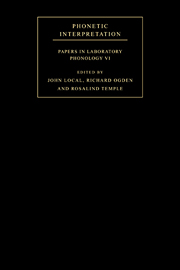Book contents
- Frontmatter
- Contents
- List of contributors
- Acknowledgements
- Introduction
- Part I Phonological representations and the lexicon
- Part II Phonetic interpretation and phrasal structure
- Part III Phonetic interpretation and syllable structure
- 11 On the factorability of phonological units in speech perception
- 12 Articulatory correlates of ambisyllabicity in English glides and liquids
- 13 Extrinsic phonetic interpretation: spectral variation in English liquids
- 14 Temporal constraints and characterising syllable structuring
- 15 Commentary: some thoughts on syllables: an old-fashioned interlude
- Part IV Phonology and natural speech production: tasks, contrasts and explanations
- References
- Index of names
- Index of subjects
11 - On the factorability of phonological units in speech perception
Published online by Cambridge University Press: 22 September 2009
- Frontmatter
- Contents
- List of contributors
- Acknowledgements
- Introduction
- Part I Phonological representations and the lexicon
- Part II Phonetic interpretation and phrasal structure
- Part III Phonetic interpretation and syllable structure
- 11 On the factorability of phonological units in speech perception
- 12 Articulatory correlates of ambisyllabicity in English glides and liquids
- 13 Extrinsic phonetic interpretation: spectral variation in English liquids
- 14 Temporal constraints and characterising syllable structuring
- 15 Commentary: some thoughts on syllables: an old-fashioned interlude
- Part IV Phonology and natural speech production: tasks, contrasts and explanations
- References
- Index of names
- Index of subjects
Summary
Introduction
Many key issues in speech perception revolve around two questions: first, what is the size of the basic phonological unit of perception (e.g. word, phoneme, feature); and, second, how general are the psycho-acoustic properties that are associated with those units. Answers to these questions vary widely. For example, the standard distinctive feature theory of Stevens and colleagues (Stevens 1989; Stevens and Keyser 1989; Stevens and Blumstein 1981) opts for units of very small size and great generality. This theory states that the transduction from signal to symbol takes place through a universal set of small units, the distinctive features, each of which is associated with well-defined psychoacoustic properties. At the opposite end of both the size and generality scales, researchers such as Goldinger (1997; see also Johnson 1997 and Pisoni 1997) suggest that the transduction from signal to symbol is mediated by an ‘episodic lexicon’, involving memory traces of exemplars (i.e. individual tokens of individual words of individual speakers). In this approach the basic phonological units are large (word-sized) elements of low generality.
My own research on speech perception (Nearey 1990, 1992, 1997, in press) has focused on phoneme-sized elements as the basic units of symbolic transduction. The acoustic patterns associated with these units are relatively general, but are clearly less so (and allowably more language-specific – yet a third sense in which my position is weaker) than Stevens's universal feature set (see Nearey 1998).
- Type
- Chapter
- Information
- Phonetic InterpretationPapers in Laboratory Phonology VI, pp. 197 - 221Publisher: Cambridge University PressPrint publication year: 2004

